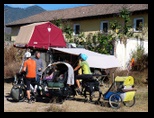
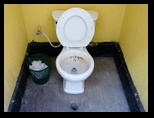
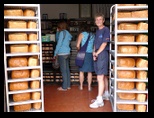

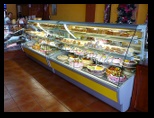

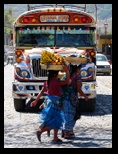

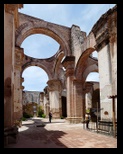
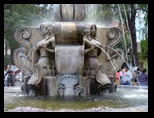
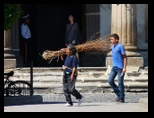


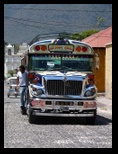
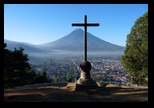

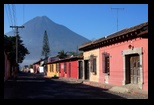

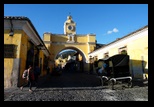

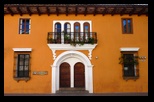
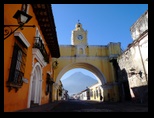



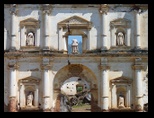
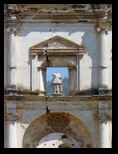
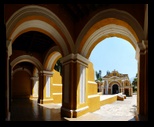
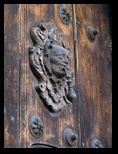

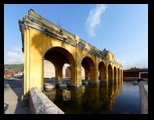
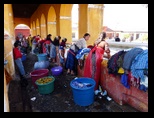
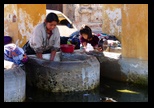
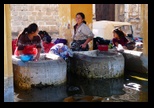
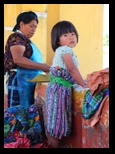
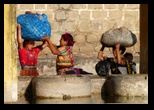

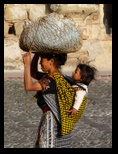
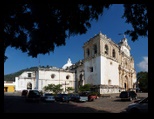
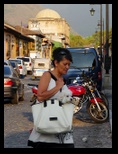
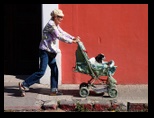

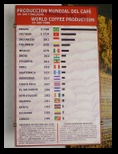
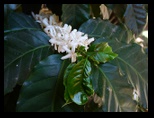
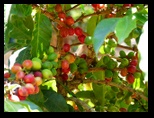
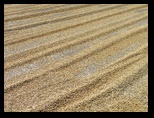
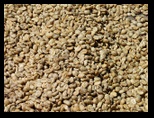
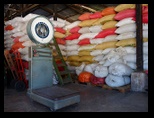
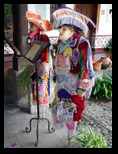
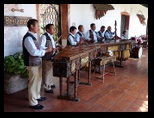

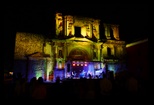
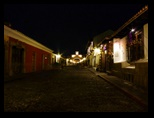
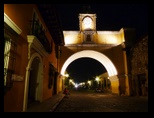
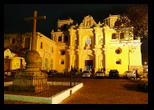
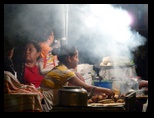
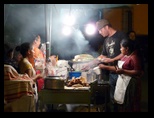


Click on a photo to enlarge it.
Antigua is a must-see highlight in Central America. It's setting is beautiful, nestled between three volcanoes, and its streetscapes
offer photo opportunities at every turn. It was founded by the Spanish in 1543 and served as the colonial capital for 233 years. The capital
was transferred to Guatemala City when an earthquake razed Antigua to the ground in 1773.
The town was slowly rebuilt retaining much of its traditional character and was designated a UNESCO World Heritage Site in 1979. Most
buildings were constructed during the 17th and 18th centuries and several ruins have been preserved and are open to the public.
The best viewpoint is from Cerro de la Cruz Mirador with a magnificent sweeping vista across the town and the volcanoes beyond.
 Antigua from above - 360° Panorama(move mouse over panorama and click on the arrows)
Antigua from above - 360° Panorama(move mouse over panorama and click on the arrows)
Volcan Fuego is easily recognizable by its plume of smoke. Another volcano nearby, Pacaya, was active but we heard it is no longer possible
to see lava flows. The best chance for that is Volcan Santa Maria south west of Quezaltenango.
Beautiful morning and view from the mirador.
We drove into Antigua late in the evening along the cobblestone streets (shake, rattle and roll for Winnie!) and parked at the tourist
police where there is a large area they use for public parking during Semana Santa. The area at the back is used for motor homes and was
overgrown when we got there although an area had been cleared off and they were in the process of clearing off the rest for Easter.
 Antigua camping at the tourist police - 360° Panorama(move mouse over panorama and click on the arrows)
Antigua camping at the tourist police - 360° Panorama(move mouse over panorama and click on the arrows)
It is free to stay here providing you clean the toilets and "donate" soap, toothpaste, toilet paper etc for the police who live here. It is
safe and secure and quiet. Perfect for us and used by a number of other travellers aswell.
We spent a week here and explored many of the streets and a lot of the colonial buildings. The main plaza has a mermaid fountain built in
1738 in its centre and the Cathedral on one side which was founded in 1542 and was built over the course of 138 years, completed in
1680. It was badly damaged during the 1773 earthquake and rebuilt. It has a baroque façade moulded from white mortar, in the elaborate
Spanish colonial style of the day. Part of the ruins have been preserved behind it and are open to the public.
There is an abundance of churches that can be visited and we also wandered around the inner courtyards of a number of very expensive
hotels. Among others we went to the Antigua Hotel which has beautiful scarlet macaws and we also got a tour of the Escuela de Cristo church
and saw the floats that were being constructed for the Easter parades.
They use aluminium frames and polystyrene blocks for the children's float that are meticulously cut into various shapes (different every
year) and then painted. The idea is to make the floats as light as possible as they will be carried through the streets for hours during
processions.
A striking example of the Baroque style is the church and convent of La Merced. It was built during the 16th century and was
partially restored in 1944. There is also the Arch (El Arco) nearby which gets a lot of attention from photographers.
Tanque de la Unión is a washing area where women used to gather every day to use the public cisterns and wash their clothes. Today
it has been brought back into use because there is no water in nearby villages. The electric bill was not paid by the local officials and
the electricity has been cut off, therefore no water pump and no water.
So the women come in every day again to use the water. Kirsten even got to help with the washing, although they complained at her because
she wasn't thorough enough!!
Washing clothes in Antigua.
We also went on a tour of Azotea coffee plantation where there is a free shuttle from the plaza. The first part of the tour shows
the Mayan way of life and they have various displays including musical instruments.
Demonstration of Mayan instrumens - Azotea Coffee Plantation.
The second part is of the plantation itself. Coffee actually comes from Ethiopia and there are two coffee plants - the Arabica plant produces one crop per year and is the best quality;
the Robusta plant has two crops per year and is lesser quality, mainly grown in Brazil and Vietnam.
At Azotea they only have Arabica coffee plants. Butterflies pollinate the white coffee flowers which smell like Jasmine and the flowers
only last for 3 days. Each flower produces one coffee bean which grows green and then turns red. There is a problem with beetles here so,
for every twenty plants, they hang up a cut open plastic bottle with kerosene in the bottom and alcohol in small container. The beetles
are attracted to the alcohol and die in the kerosene. They use an organic mix of chilli, garlic and aloe vera to protect the leaves.
The red beans are picked between November and April. The red skin is taken off by machines and there are two beans inside which are fermented
in water for 2 days and dried for 2 weeks. The dry outer skin is separated and used as compost - red worms are added for this process - the
beans are then either exported unroasted as each country has its own roasting process or they are roasted for sale in Guatemala.
The roasting process here takes 28 minutes for medium roast and 35 minutes for dark roast (which is less bitter and has less caffeine).
The best quality coffee comes from Ethiopia first and Kenya second. Guatemala and other Central American countries are in third place. Most
coffee is produced in Brazil and Vietnam. Guatemala is in 9th position. A number of growers in Antigua over produce and sell off the rest
to Starbucks.
The tour was very interesting and cost 50 Quetzals per person (approx $6.50).
There are a huge amount of restaurants for every taste and a great bakery near the cathedral that makes wonderful banana bread. There are
also two supermarkets not far from the tourist police so we certainly weren't going to starve!
We enjoyed it so much here that we really wanted to come back. We spoke to a tourist office official who told us to go to a border on the
15th March (the day before our vehicle permit expires) and we may be able to get an extension. If not, we could leave the country for 1
to 3 days and then come back in. We really hoped this would be possible and it would certainly be worth a try.